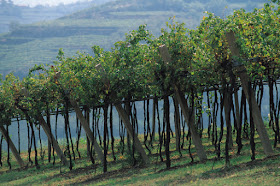The vineyards of Inama are located in the Veneto region in the northeastern part of Italy between the major towns of Verona and Vicenza. It's a wonderful region with so many beautiful towns explore including the former two mentioned as well as Padua,Venice and more. Inama's white wines hail from the historical Soave Classico wine region and the reds coming from the Colli Berici, just south of Vicenza.
 |
| Stefano Inama |
 |
| Copyright of Inama Wines |
2017 Inama "Vin Soave" Soave Classico DOC (SRP $15)
Inama's entry level soave wine. Made from 100% garganega on 30 year old vines the wine is vinified in stainless steel. This wine makes up about half of Inama's production. An easy drinking wine with medium body, fresh acidity combined with apple and tropical notes and a bit of creaminess to the texture.
Food pairings: Inama recommends risotto, white fish, sushi, local fresh ricotta and stewed peas.
2016 Inama Vigneti di Foscarino Soave Classico DOC (SRP $25)
The single vineyard, old-vine soave wine from Inama. A wine with much complexity made of 100% garganega and fermented in used barriques. The wine is aged on the lees stirred every 6 weeks for 6 months and fining takes place for 6 months in stainless steel. A creamy texture with more notes of pears and hone.
Food pairings: Inama suggests risotto with fish, sushi, veal with tuna sauce. Local dishes include baccala and soups including pea and pumpkin soup
 |
| Foscarino |
 |
| Foscarino |
A blend of 70% cabernet sauvignon and 30% carmenere. This wine spends 15 months in a mix of 50%/50% used & new barriques. A full-bodied wine rich in blackberries, cherries with some pepper. A rather smooth wine with low to moderate tannins and good acidity. The label signifies the house where he Inama family lives that was built back in the 1700's.
Food pairings: Inama suggests bbq, filet, stews. Local specialties include bigoli with sausage and asiago cheese, grilled bone-in rib eye and bean soups.
2015 Inama "Carmenere Piu" Veneto Rosso IGT ($20)
A blend of 70% carmenere and 30% merlot. Another wine rich in dark berries with chocolate notes, pepper and spice (and everything nice). The wine spends 12 months in used barriques. A unique wine, especially to see this grape dominate the blend.
Food pairings: Inama suggests pancetta & salami, grilled pork, polenta. Local dishes include sorpresa Veneta DOP, pasta and beans and Val Liona DOP ham
* Most pictures copyright of Inama winery and these wines were provided as samples, but opinions are my own.




